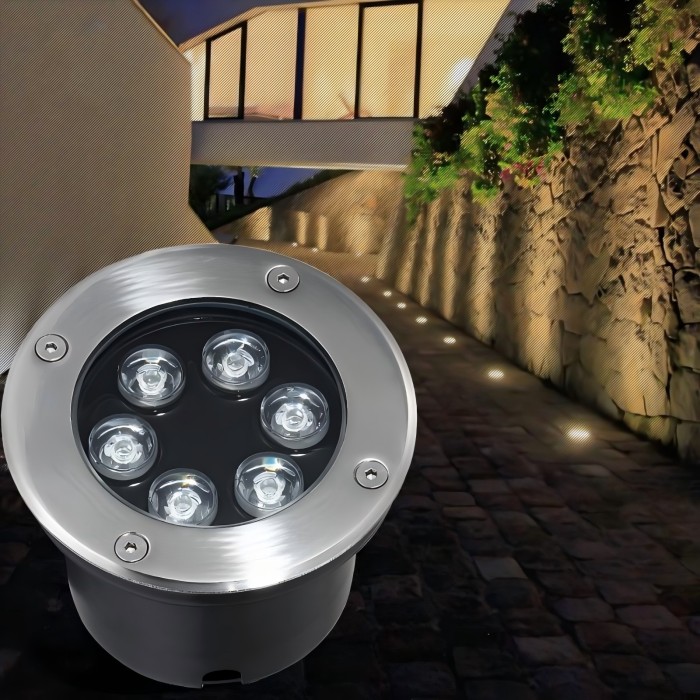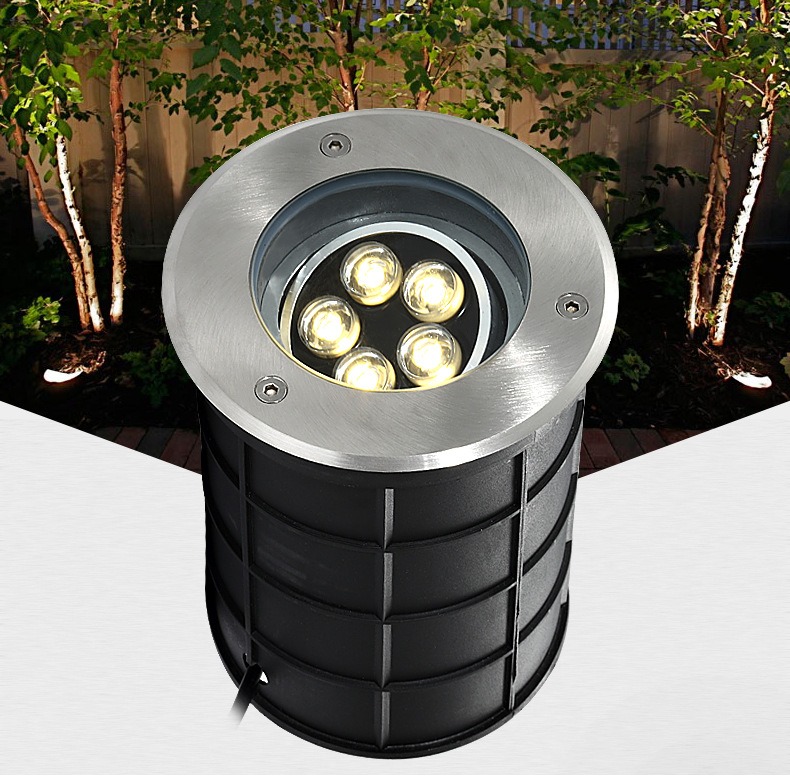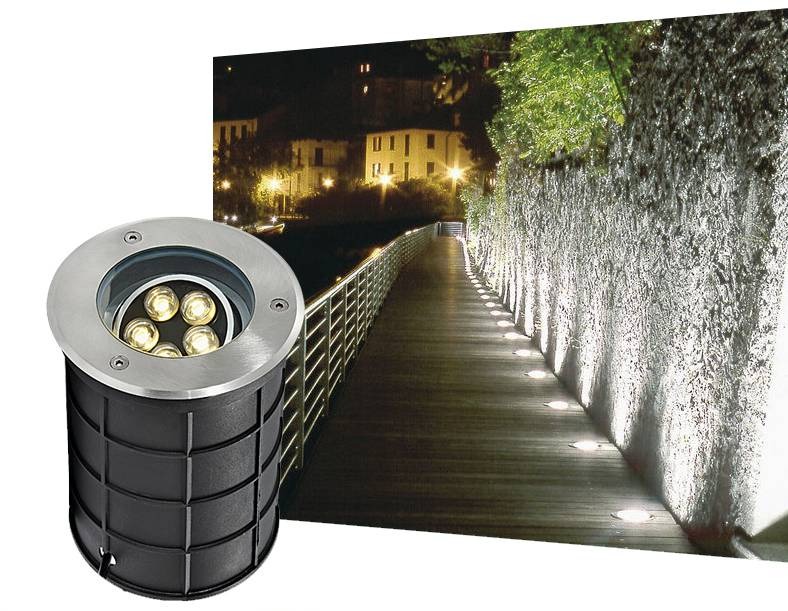1. Extremely Harsh Environmental Conditions:
Water Ingress / Submersion: This is the primary culprit! Installed within recesses below grade, in-ground lights are the luminaires most prone to prolonged water pooling and silt/mud accumulation. Even with an IP68 rating (theoretically submersible indefinitely), real-world application reveals vulnerabilities:
Breathing Effect from Thermal Cycling: Lights heat up during operation → internal air expands → subsequent cooling creates negative pressure upon contraction → If seals are aged or slightly imperfect, this suction draws in external moisture-laden, corrosive air (containing acid rain, de-icing salts).
Constant Hydrostatic Pressure: Prolonged submersion in water or mud slurry exerts continuous pressure on seals. This is particularly severe when uneven pavement causes water to pool, keeping the light's crown submerged long-term.
Structural Stress Compromising Seals: Vehicle traffic or thermal expansion/contraction causing foundation shifts can deform the light housing or unevenly compress sealing gaskets, breaking the seal integrity.
Ice Jacking: Ingressed water, freezing in winter, expands. This expansion can crack the housing or damage internal components.
Highly Corrosive Elements:
Salt Spray / De-Icing Chemicals: Road salts (de-icers like Sodium Chloride, Calcium Chloride) contain highly corrosive chlorides. Long-term exposure attacks metal housings, screws, wire terminals, PCB solder joints, and even aluminum substrates.
Acid Rain / Industrial Pollutants / Soil pH: Accelerate corrosion of metals and electronic components.
Extreme Temperature Fluctuations: Summer ground temperatures can soar above 70°C (158°F), while subsurface winter temps can plunge below -20°C (-4°F). This violent thermal cycling accelerates material degradation (seals hardening/cracking), solder joint fatigue fractures, lens cracking, and PCB delamination.
Physical Impacts & Vibration:
Vehicle Trafficking: Frequent passing vehicles subject lights to immense pressure and vibration (especially problematic on routes used by heavy vehicles).
Pedestrian Footfall: Can displace the light body or damage the top protective lens/cover.
Construction/Maintenance Equipment Impacts: Street sweepers, lawnmowers, etc., risk colliding with the lights.
2. Complex Structural Design Constraints:
High Integration, Confined Space: Light bodies are typically slender and flat. Packing LED modules, drivers, thermal management, protective seals/gaskets, mounting hardware, and wiring terminals into such a constrained volume poses immense design challenges. Achieving adequate heat dissipation, maintaining safe insulation distances, and optimizing wire routing become critically difficult.
Thermal Management Difficulties: Buried underground, heat relies on conduction through the structure (upwards to the pavement, sideways to soil). However:
Pavement materials like asphalt, concrete, or stone atop the light have lower thermal conductivity than metal.
Lateral soil contact is inconsistent, creating high thermal resistance.
High operating temperatures easily create "hotspots," accelerating LED lumen depreciation and driver failure (especially electrolytic capacitors). Submersion in water/mud can slightly improve conduction (water is a better conductor than air), but this minor benefit is vastly outweighed by the severe risk of water damage.
Cumbersome Repairs: Faulty lights require excavation, clearing debris around the base, and significant labor for access – a costly, time-consuming ordeal. This demands exceptionally high product reliability, a perfection hard to achieve.
3. Failure of Critical Components:
Driver (Power Supply): The Achilles' heel!
High temperatures rapidly aging electrolytic capacitors (loss of capacitance, increased ESR, catastrophic drying out) is the most common cause of driver failure.
Corrosive environments attacking solder joints, terminals, fuse holders, inductor windings, causing poor contacts or shorts.
Water ingress causing PCB leakage currents, short circuits, or tracking.
Impacts/vibration loosening components or fracturing solder joints.
LED Light Source:
Poor heat dissipation causes excessive heat → severe lumen depreciation (brightness loss).
Moisture/corrosive fumes penetrating → gold wire bond failures, phosphor degradation ("blackening" of LED chips), corrosion of chip carriers/boards.
Unstable driver output (e.g., high ripple current) accelerating lumen depreciation.
Connectors / Terminals: Moisture-induced oxidation/corrosion increases contact resistance → open circuits or arcing.
4. Material Degradation & Seal Failure:
Seal Degradation: Silicone gaskets harden, crack, and lose elasticity due to high heat, UV exposure (even scattered light in gaps), ozone, and chemical corrosion, ultimately failing.
Adhesive Degradation: Glues used for lens bonding or secondary sealing degrade and detach.
Housing Material Degradation: Although die-cast aluminum housings offer better corrosion resistance than some metals, pitting corrosion still occurs in high-salt, high-humidity environments. Poor-quality engineering plastic housings degrade faster, losing strength and becoming prone to deformation.
5. Non-Compliant Installation Practices:
Unstable Base / Poor Drainage: Leads to uneven mounting, stress concentration, and excessive water pooling.
Improper Wiring: Poorly terminated connections (lacking waterproofing), omission of proper waterproof connectors, inadequate cable entry sealing (missing conduit bends or proper cable glands), allowing moisture intrusion via the cable path.
Improper Seal Installation: Debris in gasket grooves, twisted seals, or uneven screw tightening during assembly.
Insufficient Burial Depth / Thin Protective Cover: Affects thermal management and makes lights more vulnerable to impact damage.
6. Downward Price Pressure Compromising Quality:
Price wars incentivize some manufacturers to cut corners: using inferior materials (thin-wall housings, cheap gaskets, non-automotive-grade electronics), simplifying designs (e.g., non-isolated drivers, inadequate heatsinks), lowering IP standards, and skipping rigorous testing (e.g., extended high-temp/high-humidity aging tests, salt spray tests).
Strategies to Reduce Failure Rates (Recommendations for Selection & Maintenance)
Procure High-Quality Products:
IP Rating: Strict, verified IP68 certification (ensure testing included pressure and thermal shock).
Driver: Choose reputable brands featuring high-temp tolerance (105°C capacitors), and either potting (glob-top or full) or over-molded designs for waterproofing/moisture resistance. Derate driver capacity (e.g., operate at ≤70% max load). Consider externally mounted drivers (in a waterproof junction box) with meticulous attention to cable entry seals.
Structural Design:
Compartmentalization: Physically isolate driver compartment from lighting compartment (requires careful thermal conduction management and sealing penetrations).
Robust Construction: Favor single-piece castings or extremely sturdy assemblies (minimizing joints). Screw-less cover designs are preferable (e.g., clips/bolts + perimeter compression seals).
Substantial Material Thickness: Ensure die-cast aluminum walls are adequately thick (≥3mm recommended); stainless steel is superior but costlier.
Light Source: Opt for top-tier LED chips (e.g., Lumileds, Cree, Osram) on reliable substrates (e.g., ceramic).
Sealing Materials: Specify high-grade silicone gaskets (e.g., Liquid Silicone Rubber - LSR). Consider multi-stage sealing (e.g., O-ring + face seal).
Certifications & Reports: Demand proof: Third-party IP68 certificates, long-duration (e.g., 1000 hours) 85°C/85% RH testing reports, and extended salt spray test results (e.g., 500+ hours).
Enforce Compliant Installation:
Ensure Solid Base & Drainage: Robust concrete foundation, drain holes at the base of the sleeve or a gravel drainage layer.
Proper Cable Entry: Use high-quality waterproof cable glands (e.g., PG-threaded type).
Waterproof Wire Connections: Employ waterproof splice connectors or meticulous waterproof tape wrapping/potting compound application.
Meticulous Seal Installation: Clean gasket channels, ensure gasket lays flat/unwrinkled, compress evenly (tighten bolts/cross-bolts gradually and uniformly).
Protect During Construction: Prevent trampling, rolling equipment over lights during site work. Backfill carefully and fully restore pavement after installation.
Consider Design & Application Adjustments:
Avoid installation on heavy-duty vehicle routes or in chronic flood zones.
Explore Driver Externalization: Relocate the vulnerable (water/heat-sensitive) driver to a nearby waterproof access box, retaining only the LED module in the ground light. (Crucially maintain cable and entry seal integrity.)
Consider HV DC or AC Direct Drive: Mitigate issues from high currents and associated heat/line losses inherent in low-voltage DC systems (require mature, stable driver technology).
Conclusion
The high failure rate of outdoor in-ground lights is a systemic challenge, stemming from the confluence of brutal environmental conditions, complex engineering constraints, critical component vulnerabilities, material longevity issues, installation quality, and competitive market pressures. Chronic moisture/water ingress and elevated temperatures stand as the twin executioners, directly or indirectly triggering seal failures, degradation of electronic components (especially electrolytic capacitors), structural damage, and material breakdown. Addressing this demands a holistic approach spanning the entire lifecycle: superior design, material selection, stringent manufacturing quality control, meticulous installation, and proactive maintenance. Selecting rigorously designed, tested, and certified high-performance products, coupled with flawless installation practices, is paramount to reducing failure rates – even if it entails higher initial costs. For critical areas or difficult-to-service locations, externalizing the driver unit often emerges as the more resilient strategy.






